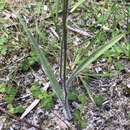en
names in breadcrumbs


Caladenia attingens, commonly known as mantis orchid, is a species of flowering plants in the orchid family Orchidaceae and are endemic to the south-west of Western Australia. There are three subspecies, each of which has a single hairy leaf and one or two brightly coloured flowers with upswept sepals and a labellum with long, comb-like fringes. The subspecies differ in size, distribution and habitat.
Caladenia attingens is a terrestrial, perennial, deciduous, herb with an underground tuber and a single erect, hairy leaf 5–20 cm (2–8 in) long and 5–12 mm (0.2–0.5 in) wide. The lower part of the leaf often has reddish blotches.[2][3][4][5]
There are one or two flowers on a hairy spike 12–45 cm (5–20 in) high, each flower 4–8 cm (2–3 in) long and 2–7 cm (0.8–3 in) wide. The flowers are green, white and yellow with reddish-purple areas. The dorsal sepal is erect, sometimes curves forward, 3.5–6 cm (1–2 in) long, 1.5–3 mm (0.06–0.1 in) wide with a swollen glandular tip 10–20 mm (0.4–0.8 in). The lateral sepals are 3.5–6 cm (1–2 in) long, 1.5–4 mm (0.06–0.2 in) wide and upswept with a glandular tip similar to the one on the dorsal sepal. The petals are 2–4 cm (0.8–2 in) long, 1–2 mm (0.04–0.08 in) long, spread widely and usually lack a glandular tip. The labellum is greenish-yellow with a red tip and four or more rows of dark red calli along its centre. The sides of the labellum bear long, green, comb-like teeth. Flowering occurs between August and November.[2][3][4]
Caladenia attingens was first formally described by Stephen Hopper and Andrew Brown in 2001 and the description was published in Nuytsia.[6] The specific epithet (attingens) is a Latin word meaning "reaching to" or "attaining", referring to the calli which extend as far as the tip of the labellum.[3]
When Hooper and Brown described the species, they also described two subspecies, C. attingens subsp. attingens[7] and C. attingens subsp. gracillima.[8] Since then, a third subspecies has been described by Andrew Brown and Garry Brockman and given the name C. attingens subsp. effusa.[9]
Mantis orchids occur between Perth and Israelite Bay, growing in a range of habitats, depending on subspecies.[2]
All three subspecies of Caladenia attingens are classified as "Not Threatened" by the Western Australian Government Department of Parks and Wildlife.[10]
Caladenia attingens, commonly known as mantis orchid, is a species of flowering plants in the orchid family Orchidaceae and are endemic to the south-west of Western Australia. There are three subspecies, each of which has a single hairy leaf and one or two brightly coloured flowers with upswept sepals and a labellum with long, comb-like fringes. The subspecies differ in size, distribution and habitat.